“In all things of nature, there is something of the marvellous.” — Aristotle
One of the most paramount proficiencies in football lies in retaining possession.
Hence, players adept at maintaining control and manoeuvring within confined areas enjoy a distinct advantage in a game where inherent talent is notably constrained.
Particular midfielders can dictate the flow of matches through a specific trait: Press Resistance.
As the name implies, this trait involves defying intense pressure from opponents while controlling the ball, necessitating the ability to hold onto it even in cramped spaces.
This can be collective or individual, where the team needs to get out of the main pressure areas or break through defences.
This may be achieved individually through players with specific attributes, as we will explain.
Press resistance constitutes a multidimensional aptitude, combining technical, tactical, and psychological attributes.
Grasping the theoretical foundations of press resistance holds paramount importance.
This tactical analysis delves into the intricacies of this skill, shedding light on its nuanced aspects.
Press resistance
“I want players who can make decisive moves in small spaces” — Johan Cruyff
In essence, press resistance is the skill of holding onto the ball when faced with opposition pressure, and space is at a premium.
This ability isn’t innate in every footballer; it’s a form of artistic prowess.
Over the past decade, football has undergone a significant change characterised by more high-pressure, counter-pressing, narrowing space, and compact structures with a high defensive line.
Coaches are now trying to form the best mechanism for the team as a whole while containing the talent of individuals and developing it within the system.
A 2016 article by Thomas Hoffman and Danish publication ‘Videnskab’ referenced contemporary scientific research from Dan Fransson, Peter Krustup and Magni Mohr and a paper called: ‘Science and Medicine in Football’ which backed up claims of a faster modern game using data.
The researchers essentially came to the conclusion that the pace of a typical football match, particularly at the highest levels, had increased dramatically over the 10-year period they’d analysed, meaning players were making more sprints, getting less time on the ball and — crucially — less decision-making time.
This increased amount of pressure also means coaches have had to train players slightly differently in order to adapt to the current landscape.
This includes an evolution towards greater press resistance.
Amidst this evolution, between the old and the new, players like Andrea Pirlo, Sergio Busquets, Paul Scholes, Marco Verratti, Luka Modrić, Mousa Dembélé, Bernardo Silva, Mateo Kovačić, Frenkie de Jong, Thiago Alcântara, and Moisés Caicedo could be heralded as standout figures, wielding a substantial impact that renders them indispensable to their respective squads.
As Manchester City‘s coach Guardiola once commented about Kevin De Bruyne, “He is not a controller but instead more dynamic, coming from behind, finishing, crossing, appearing here, then there, defending, attacking… less control and much more movement.”
Not every skilled or seasoned player possesses the capability to dictate the tempo of play in this manner.
In moments of uncertainty when neither team appears to be in complete control, these players shine.
Their actions, whether a subtle body feint, a delicate flick, or a seemingly routine pass, propel their teams into positions of dominance.
In football, it moves between in-possession to defensive transitions, then out-of-possession, and then offensive transitions.
Here, in cases of offensive transition, the presence of these types is to get out of the pressure zone and execute swift counterattacks or continue possession and effortlessly escape congested areas while adeptly eluding high-pressure scenarios without resorting to complex tactical buildup or progression patterns.
Their exceptional skills provide coaches with innovative individual solutions.
Should there be scepticism, one only needs to place another player in the same vulnerable circumstances and witness the contrasting outcomes firsthand.
Technicality
“The most complicated skill is to be simple.” — Dejan Stojanovic
The facets of press resistance exhibit diversity among players, harmonising various attributes, including technical finesse, tactical understanding, vision, precise passing, mental resilience, and psychological conditioning.
These elements intertwine, forming a delicate equilibrium that distinguishes present-day players like Frenkie de Jong, Moisés Caicedo, Enzo Fernández, and past figures like Mousa Dembélé.
These individuals typically possess a rare fusion of technical proficiencies.
For instance, they master the art of controlling the ball under pressure from the very first touch, swiftly manoeuvring it with their bodies or in unexpected directions, showcasing remarkable intuitive speed.
Time seems to slow down for them, enabling split-second decisions and rendering opponents appear sluggish.
Thiago Alcântara’s capability to instantaneously alter the ball’s trajectory, accelerating play’s pace and launching it into space through a solitary touch, remains consistently astounding.
Close proximity to the ball and the art of retention constitute enduring skills in this sport.
Navigating tight spaces through dribbling becomes a means to elude pressure.
For such midfielders, bypassing pressing, regardless of its intricacy, can remarkably shape tactics and movement and outmanoeuvre opposing lines with minimal gestures.
These demands necessitate swift decision-making, honed through rigorous training that etches actions into the subconscious.
The velocity of this decision-making, honed through experience, demands profound tactical awareness encompassing spatial cognition, teammates, and adversaries achieved through permanent scanning.
Scanning, a crucial tool, enriches decision-making.
This entails players momentarily shifting their focus from the ball to absorbing additional information.
Arsène Wenger in 2019 about scanning.
“What is interesting is that very good players scan six to eight times in 10 seconds before getting the ball, and normal ones three to four times.”
Furthermore, off-the-ball movement holds immense significance, grounded in spatial consciousness, team dynamics, and an astute comprehension of opponents’ pressing patterns.
This awareness forms the bedrock of trust, communication, and composure within any team system.
Musicians
“Technique is the ability to translate your ideas into sound through your instrument.
This is a comprehensive technique.” — Stan Getz
In today’s global football landscape, two standout figures provide illuminating examples of these pivotal roles: Moisés Caicedo, recently transitioning from Brighton to Chelsea, and Frankie de Jong, the notable Barcelona player.
Their excellence vividly illustrates the impact of their unique talents.
Under Roberto De Zerbi at Brighton & Hove Albion, the significance of Moisés Caicedo quickly came to the forefront.
Rapid decision-making is paramount in a captivating tactical system reliant on intricate short passes within confined spaces.
Caicedo adeptly navigated this milieu, enticing opponents to press and delivering unexpected, high-risk passes deftly.
The pass map below underscores his influence, revealing his mastery over the team’s tempo.
His teammates exuded confidence in passing to him during challenging moments, given his capacity to evade pressure and drive progress.
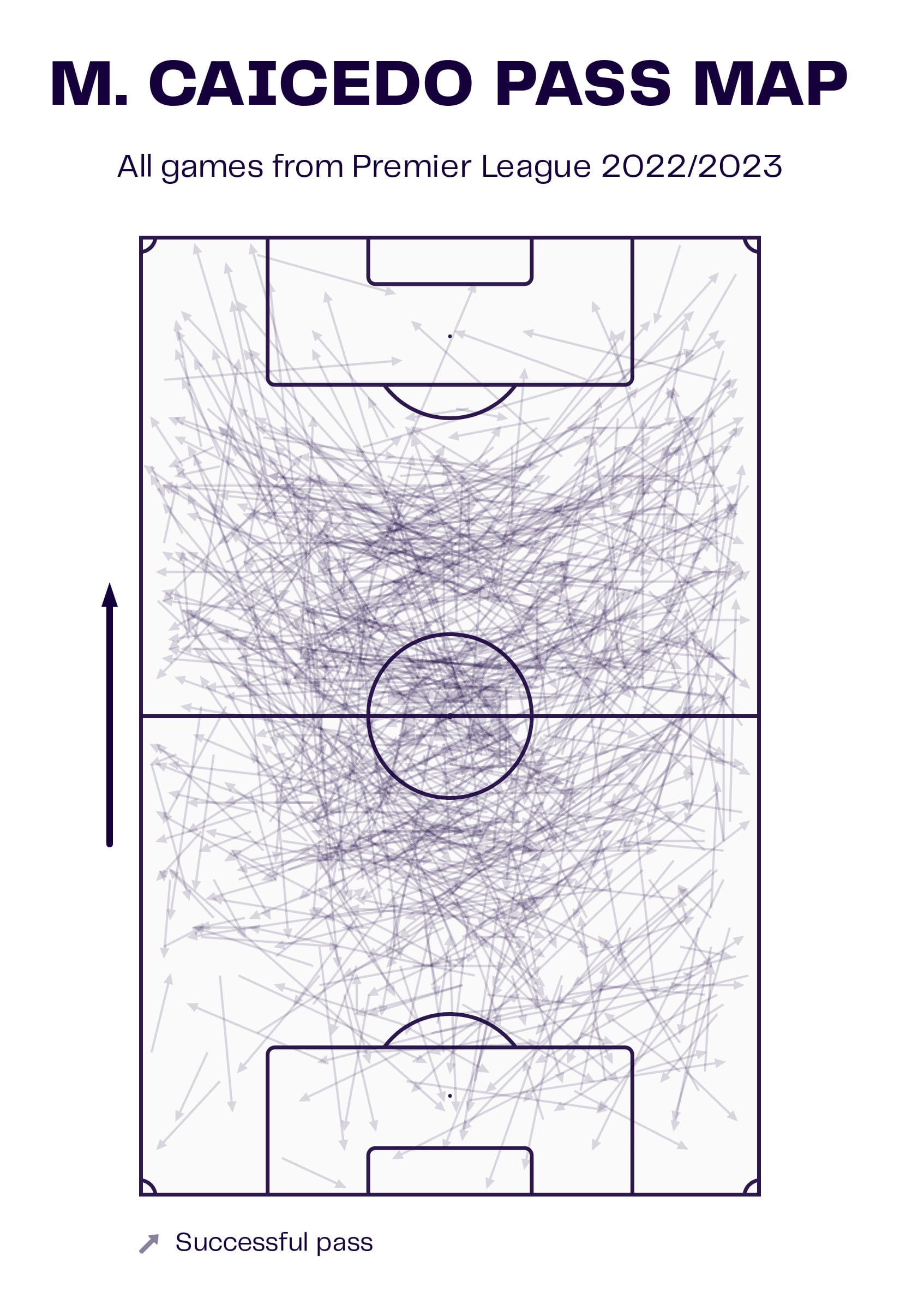
In Spain, Frenkie de Jong demonstrates his trademark creativity and midfield command, characterised by technical prowess in a league emphasising finesse over physicality.
The graphic below illustrates his integral role in Xavi’s system, which ultimately integrated Sergio Busquets, Frenkie de Jong, Gavi and Pedri.
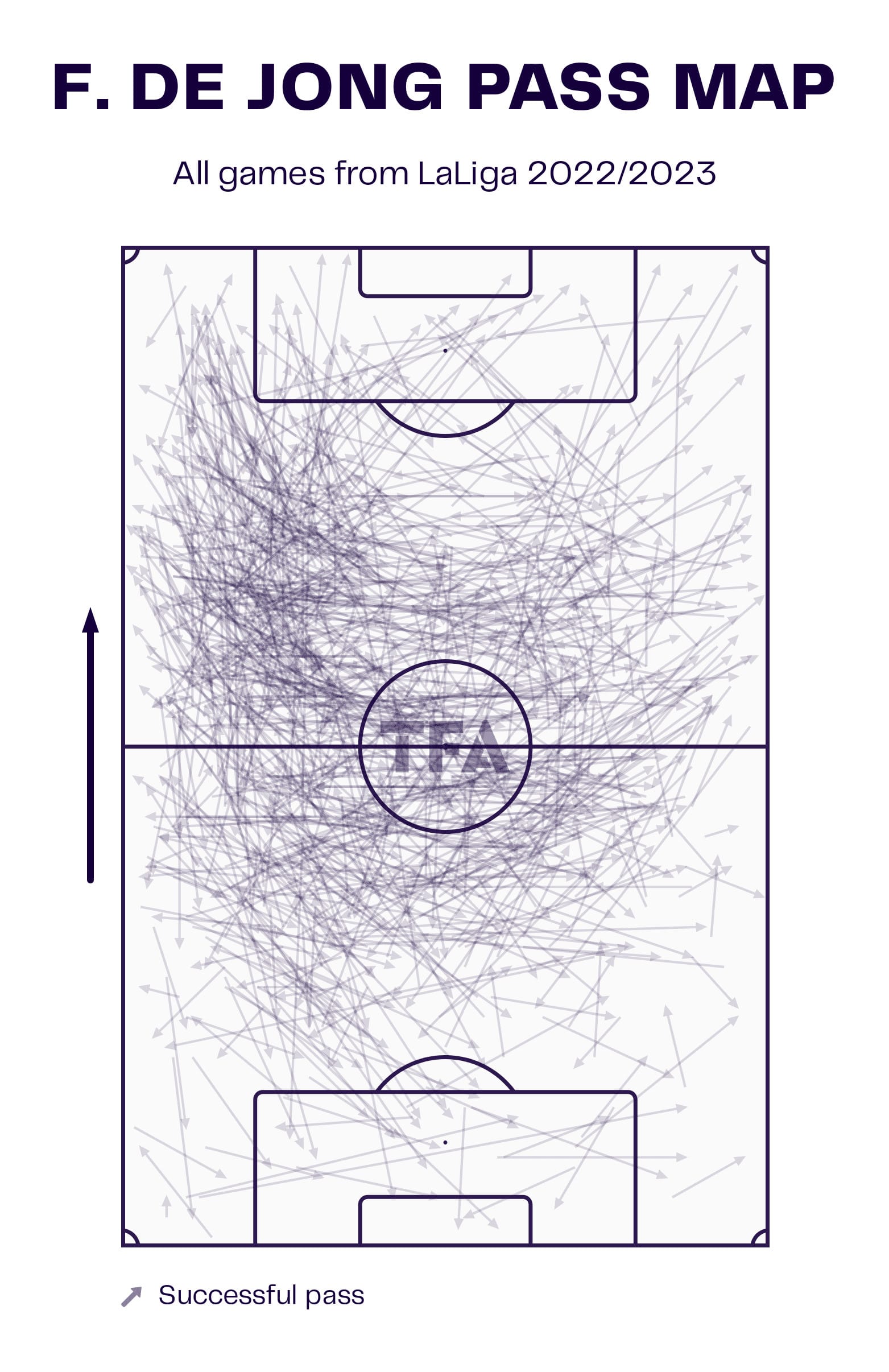
Both players possess the innate ability to envision the larger play, executing passes that unveil their brilliance moments later.
Their impeccable body positioning upon receiving the ball paves the way for timely passes—be they progressive, dribbles, or pressure-breaking feints.
The crux lies in effective ball progression.
These midfield maestros don’t necessarily rely on lofty goals or assists to be elite.
After all, the ball doesn’t mystically traverse into the net; it necessitates adept passing, skilful dribbling, and the capability to advance the ball through carrying.
Ball retention stands as an exquisite art form.
They have achieved mastery in safeguarding the ball forward, skillfully positioning their bodies between it and the opposition while adeptly manoeuvring through confined areas.
Here below is Frenkie de Jong and Moisés Caicedo’s progressivity (passes and dribbles) last season.
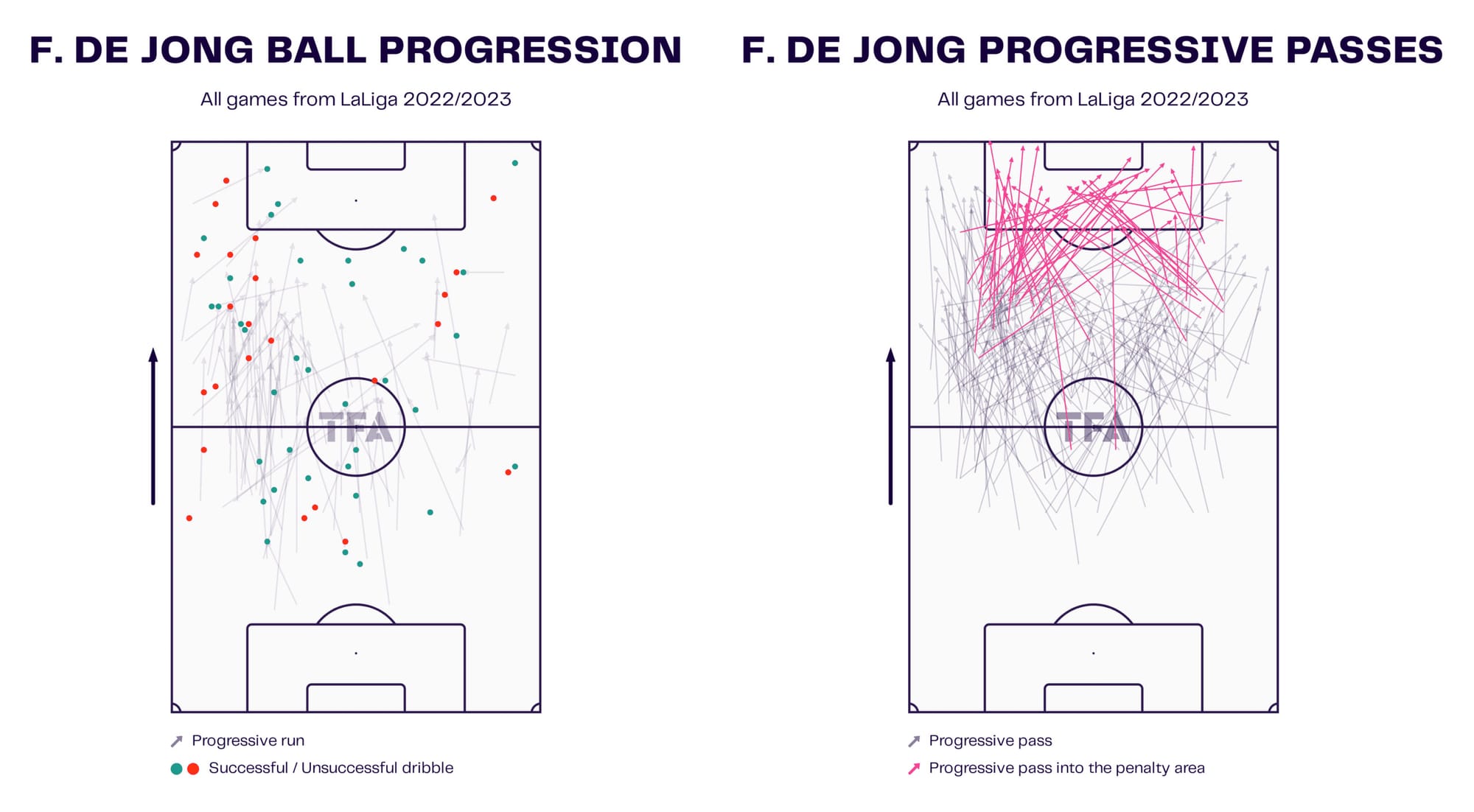
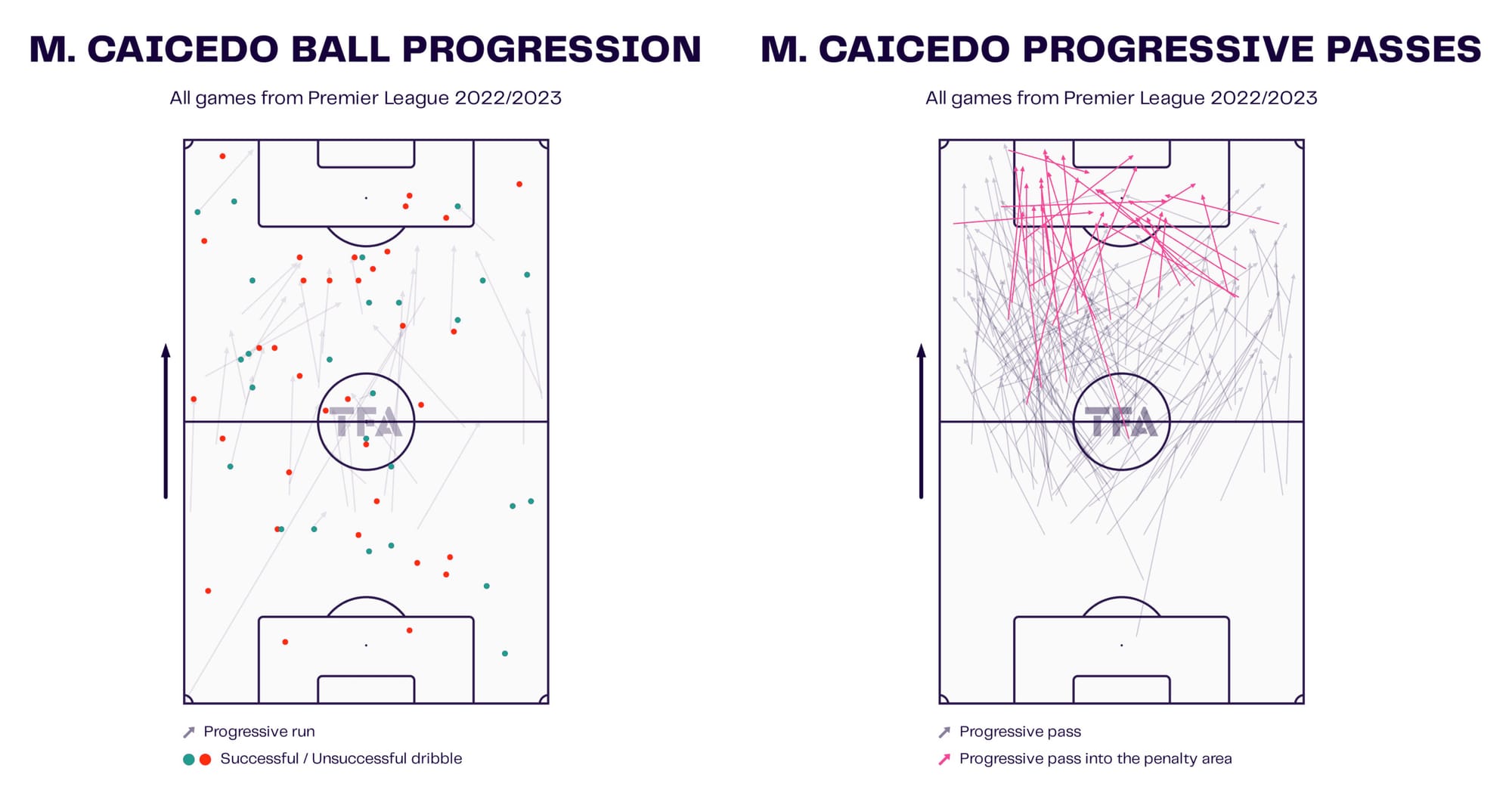
According to Wyscout, Frenkie de Jong averaged 68.65 (92.3%) passes, 50.68 received passes and 20.71 (87.9%) forward passes per 90 while Moisés Caicedo had 54.49 (90.3%) passes, 40.46 received passes and 14.07 (80.5%) forward passes last season.
In a match between Brighton and Manchester United, Moisés Caicedo showcased exceptional press resistance.
Under intense United pressure, Caicedo received the ball following a skilful separation from Eriksen, rapidly altering his pace and body dynamics.
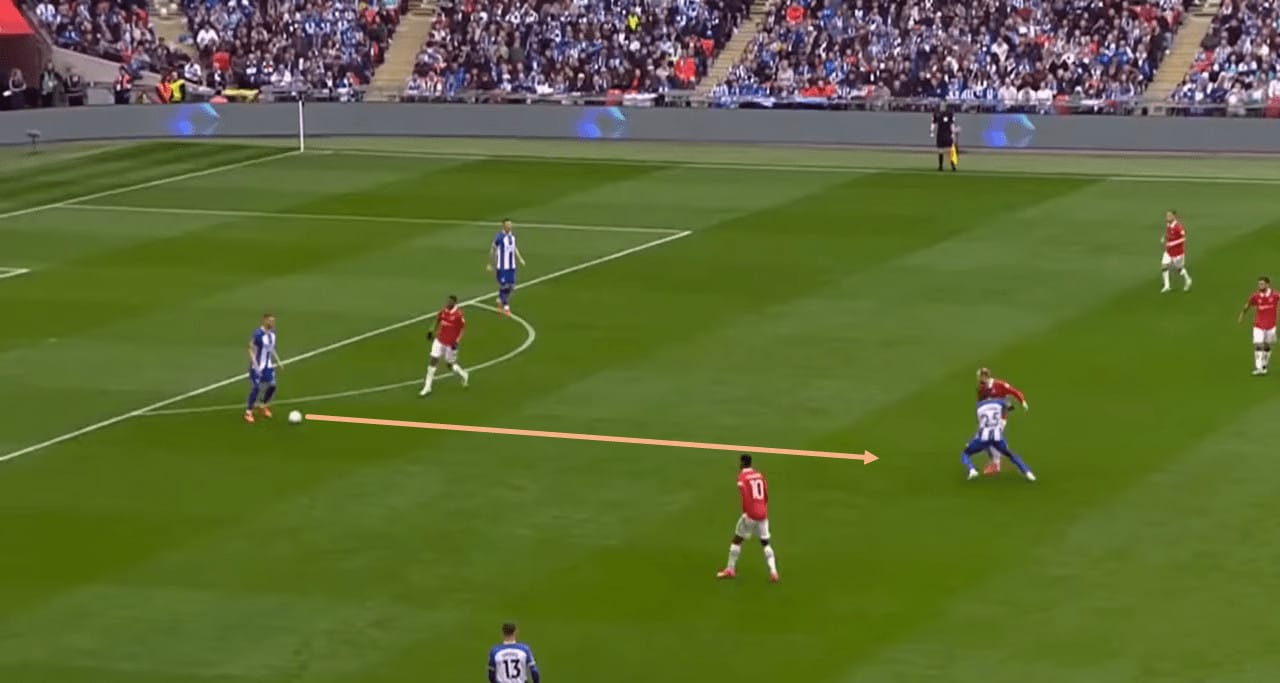
Instead of opting for the straightforward pass to the available centre-back, he surprised everyone by swivelling his body and executing an unexpected pass that penetrated the pressure lines.
This decision was a result of his continuous scanning, highlighting his ability to process real-time information and make calculated choices under pressure.
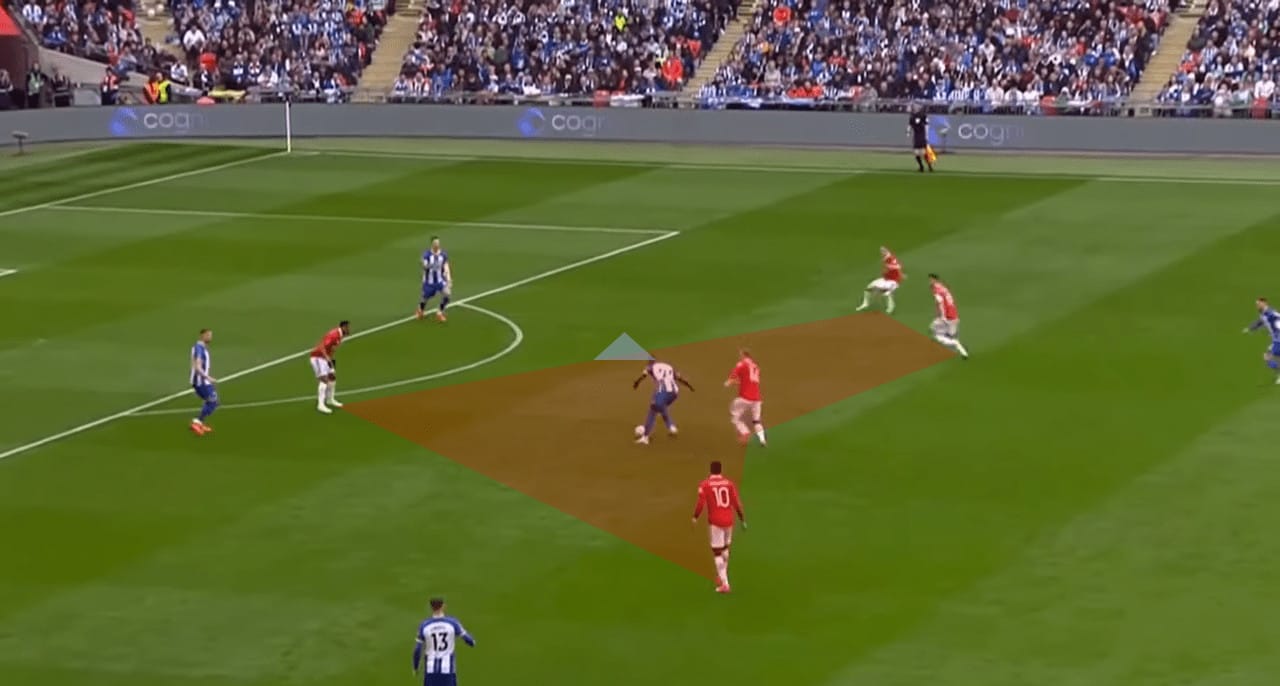
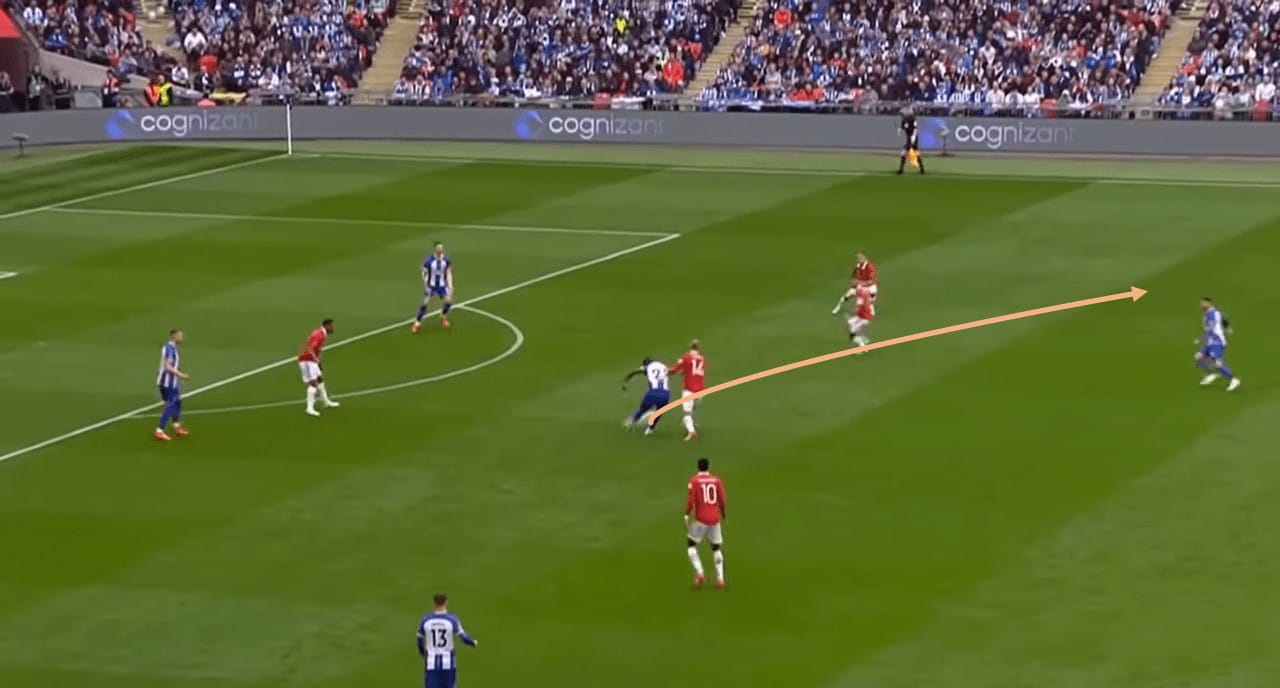
In a scenario against Bayern, Frenkie de Jong demonstrated his prowess.
Positioned amidst four opponents, his skill in ball-carrying and outmanoeuvring opponents was on display.
Among the quartet, he cleverly lured them to one side, utilising his body positioning to shield the ball.
Concurrently, he scanned the field, assessing his options for a possible pass.
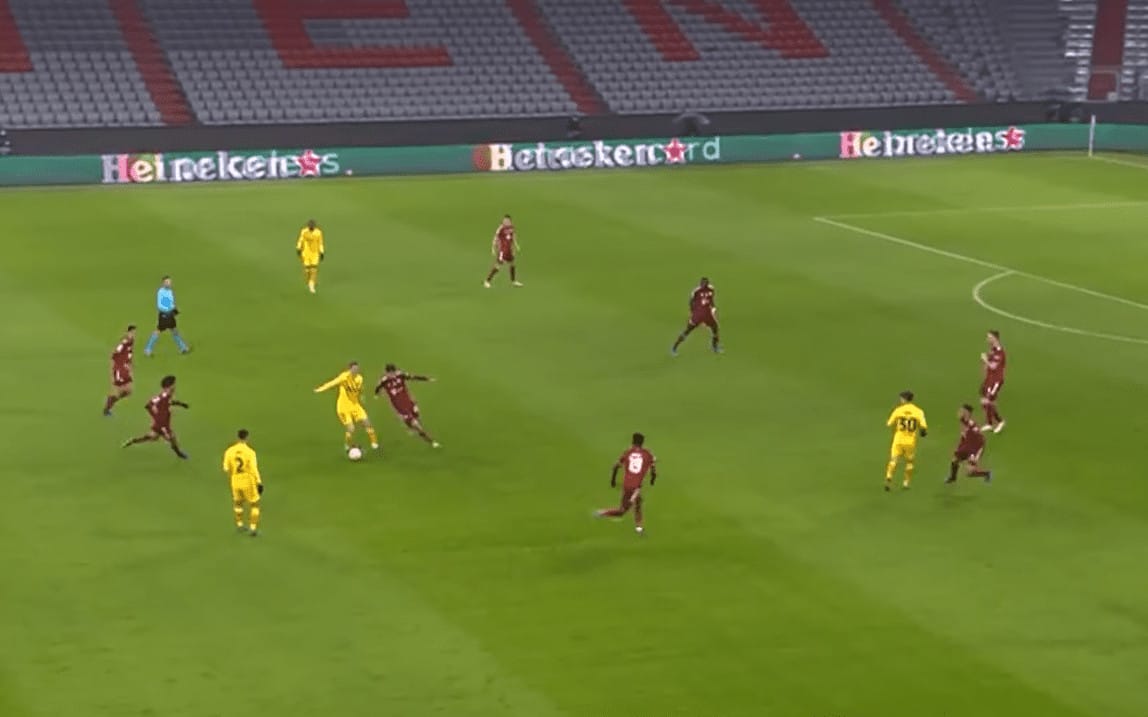
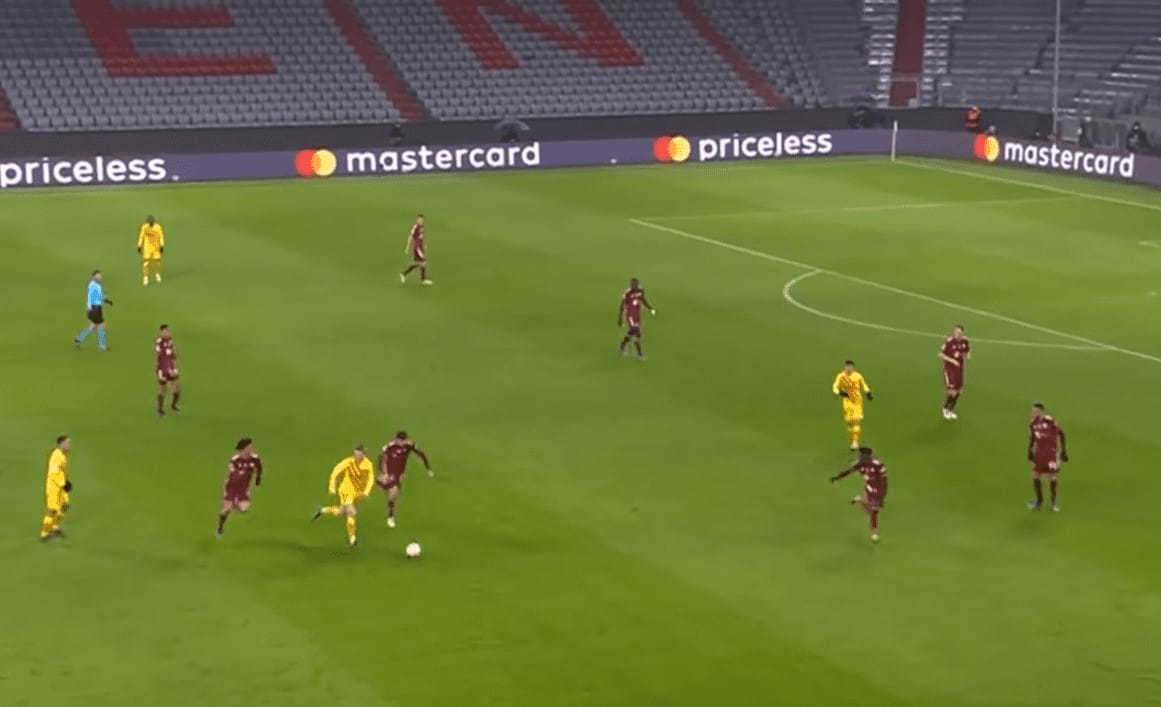
Simultaneously, he noted the positioning of his teammate, Sergiño Dest behind him.
With deftness, he executed a brilliant backheel pass to Dest, effectively drawing the opponents out of position and redistributing the ball with reduced pressure.
This sequence exemplifies his ability to manipulate the game’s dynamics through his vision, control, and split-second decision-making.
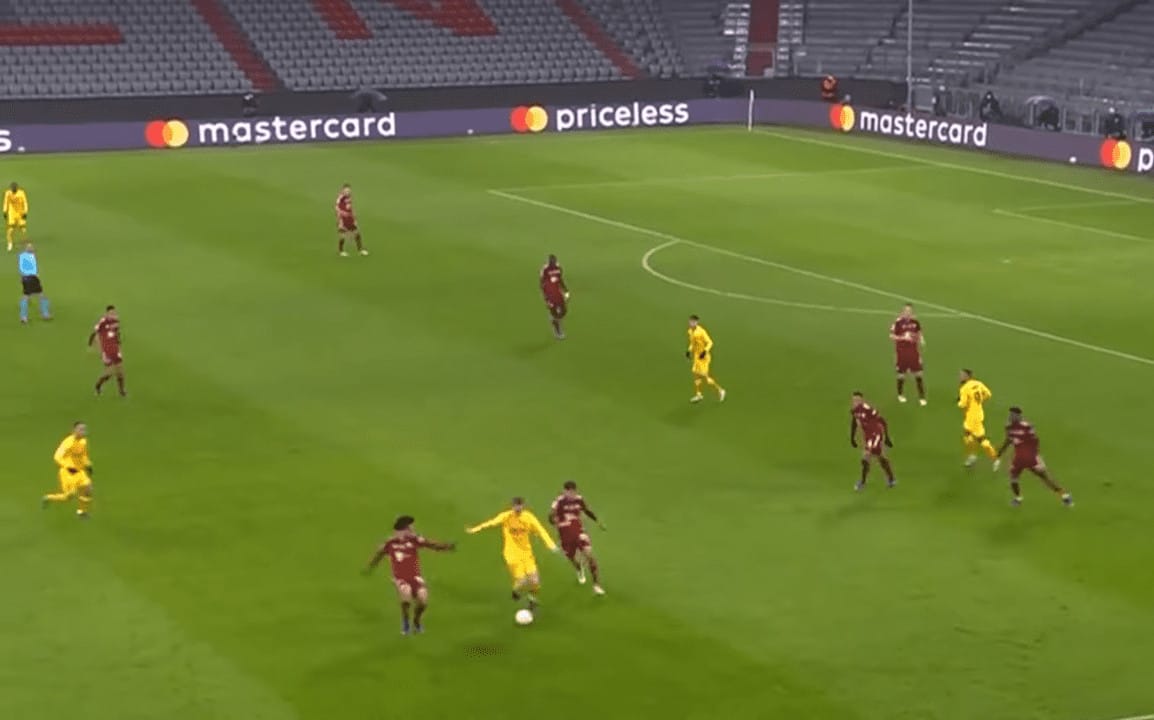
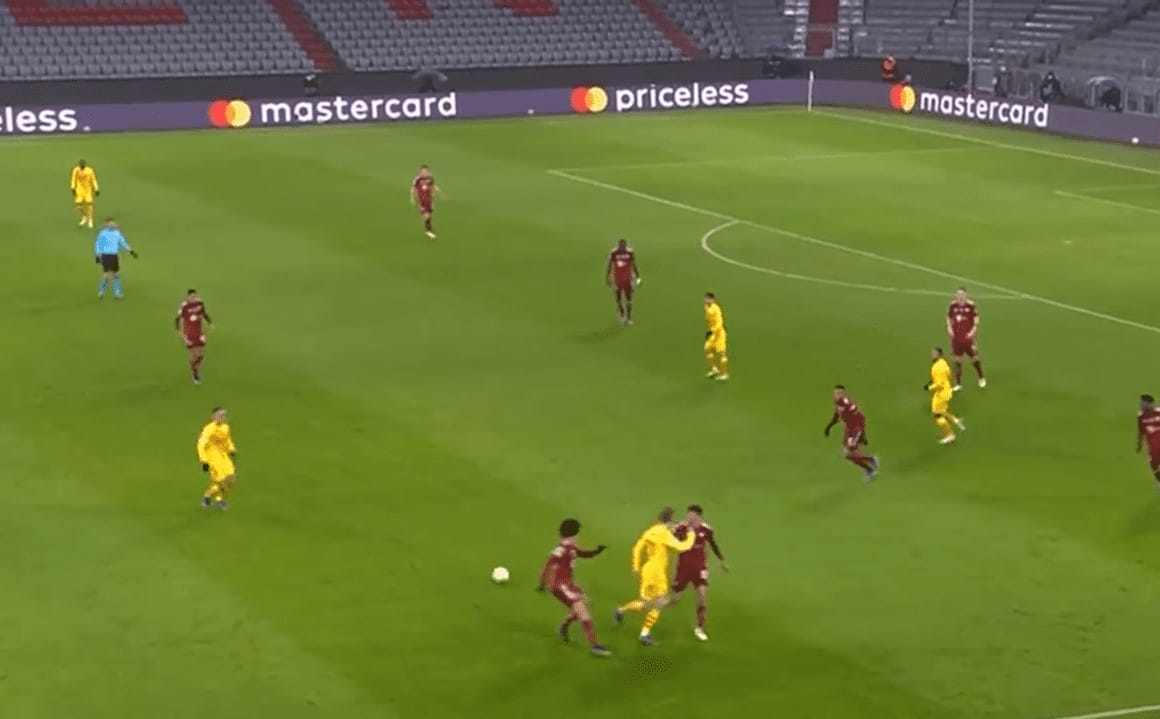
Conclusion
The analysis illustrates the impact of these players’ types on the tactics.
The skill of press resistance in football, embodying technical finesse, tactical insight, and mental strength, emerges as an art form.
Players like Frenkie de Jong and Moisés Caicedo epitomise this skill, retaining possession under pressure and navigating tight spaces.
Their abilities bridge traditional and modern football, impacting matches through precise passing, intuitive movement, and strategic decision-making.
Scanning enhances their cognitive agility, while off-ball awareness fosters trust within teams.
This multidimensional skill, exemplified in notable players, reshapes the sport, showcasing the seamless blend of technique and artistry on the field.

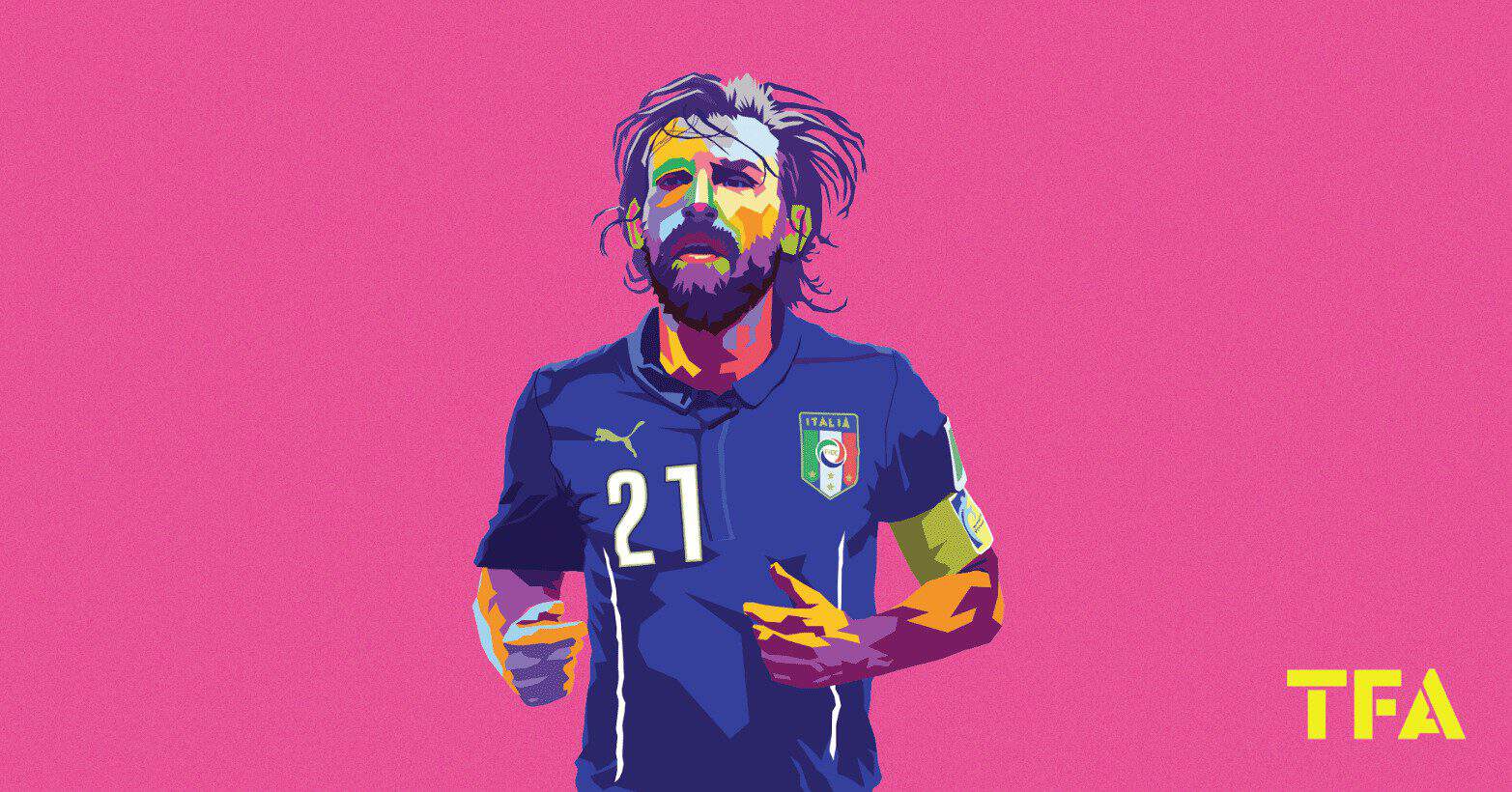



Comments